Implementing Change Management Process for Aussie Financial
VerifiedAdded on 2023/06/09
|14
|3020
|482
Project
AI Summary
This project report details the implementation of a change management process for Aussie Financial and Accounting Company (AFAC), a leading financial services firm in Australia. The project encompasses various aspects, including the application of policies for change requests and approval procedures, the development of an effective communication plan for stakeholders, and strategies for gathering feedback through performance audits and user interviews. The report outlines performance evaluation methods, a comprehensive time plan, vendor and product information, and strategies for liaising with affected persons and engaging key stakeholders. Furthermore, the project prioritizes project requirements, analyzes training needs, and establishes a plan for documenting actions, culminating in a detailed conclusion and references. The project's aim is to facilitate a smooth transition to a new IT infrastructure, considering the company's current centralized system and the need for a distributed architecture, with a focus on improving operational efficiency and customer satisfaction. The project also focuses on the importance of proper communication and training to ensure employees are comfortable with the new system, which will ultimately improve their work and make it easier.

IMPLEMENT CHANGE MANAGEMENT PROCESS 1
Implement change management process
Name of student
Name of instructor
Name of institution
Date
Implement change management process
Name of student
Name of instructor
Name of institution
Date
Paraphrase This Document
Need a fresh take? Get an instant paraphrase of this document with our AI Paraphraser
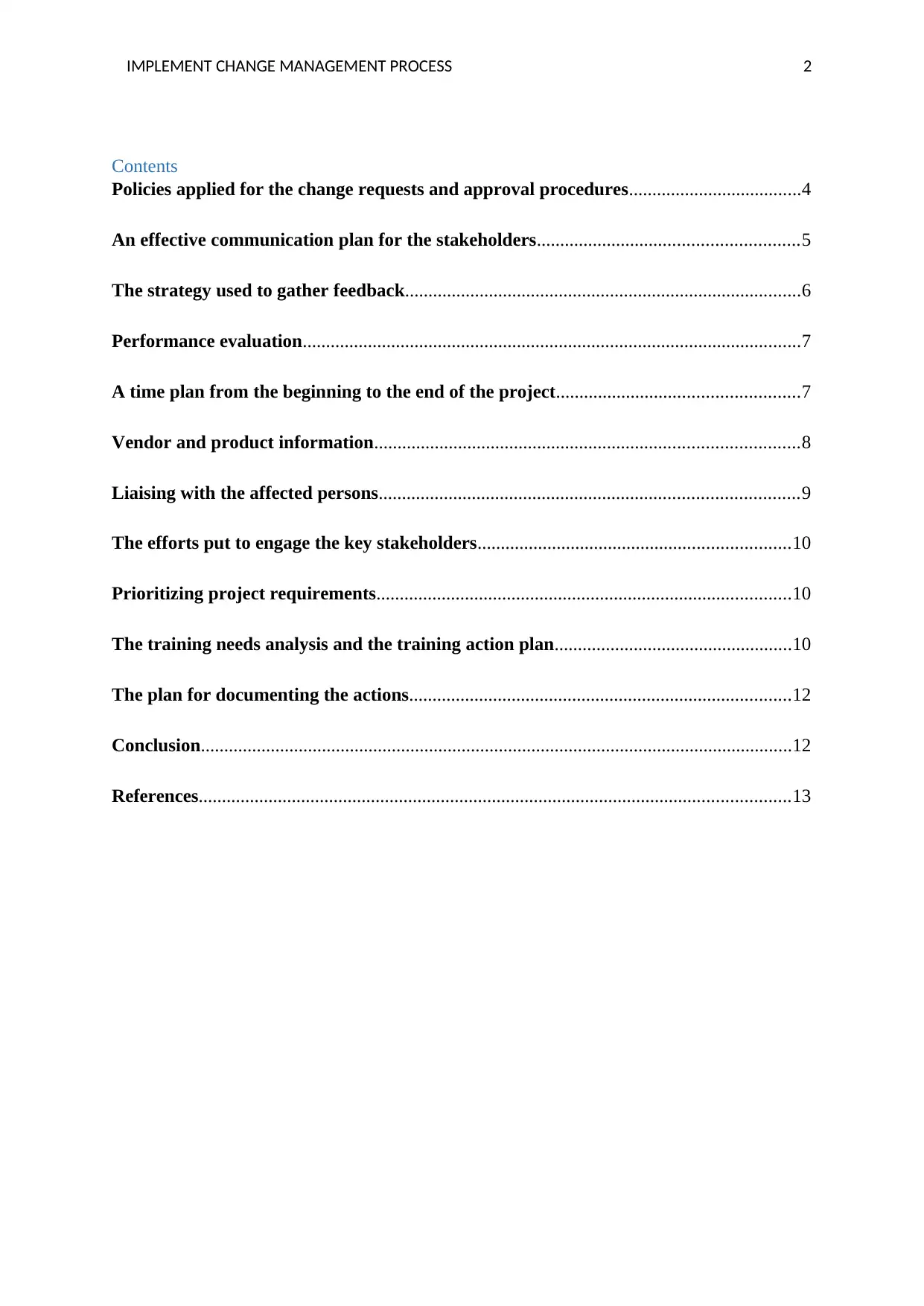
IMPLEMENT CHANGE MANAGEMENT PROCESS 2
Contents
Policies applied for the change requests and approval procedures.....................................4
An effective communication plan for the stakeholders........................................................5
The strategy used to gather feedback.....................................................................................6
Performance evaluation...........................................................................................................7
A time plan from the beginning to the end of the project....................................................7
Vendor and product information...........................................................................................8
Liaising with the affected persons..........................................................................................9
The efforts put to engage the key stakeholders...................................................................10
Prioritizing project requirements.........................................................................................10
The training needs analysis and the training action plan...................................................10
The plan for documenting the actions..................................................................................12
Conclusion...............................................................................................................................12
References...............................................................................................................................13
Contents
Policies applied for the change requests and approval procedures.....................................4
An effective communication plan for the stakeholders........................................................5
The strategy used to gather feedback.....................................................................................6
Performance evaluation...........................................................................................................7
A time plan from the beginning to the end of the project....................................................7
Vendor and product information...........................................................................................8
Liaising with the affected persons..........................................................................................9
The efforts put to engage the key stakeholders...................................................................10
Prioritizing project requirements.........................................................................................10
The training needs analysis and the training action plan...................................................10
The plan for documenting the actions..................................................................................12
Conclusion...............................................................................................................................12
References...............................................................................................................................13
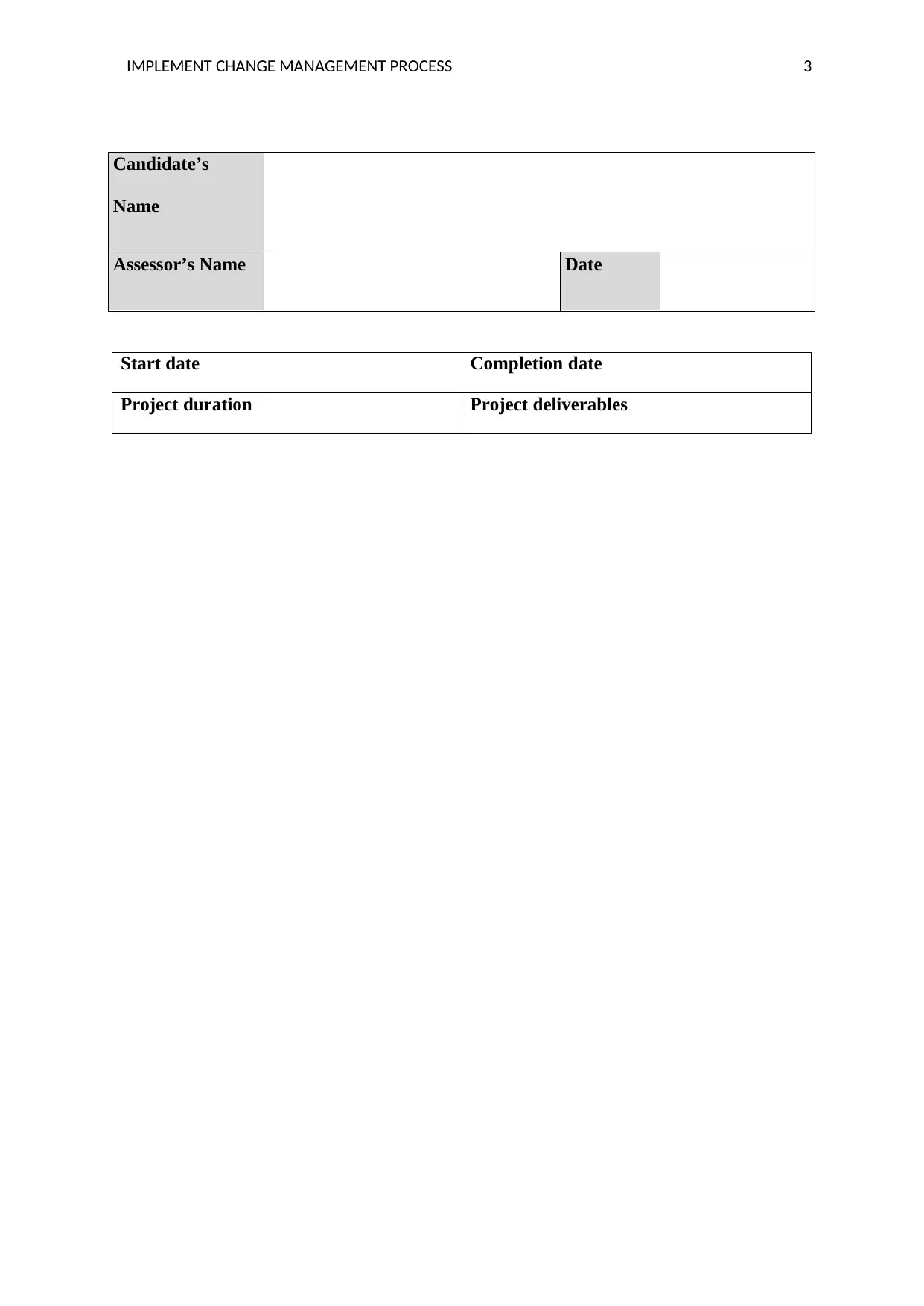
IMPLEMENT CHANGE MANAGEMENT PROCESS 3
Candidate’s
Name
Assessor’s Name Date
Start date Completion date
Project duration Project deliverables
Candidate’s
Name
Assessor’s Name Date
Start date Completion date
Project duration Project deliverables
⊘ This is a preview!⊘
Do you want full access?
Subscribe today to unlock all pages.

Trusted by 1+ million students worldwide
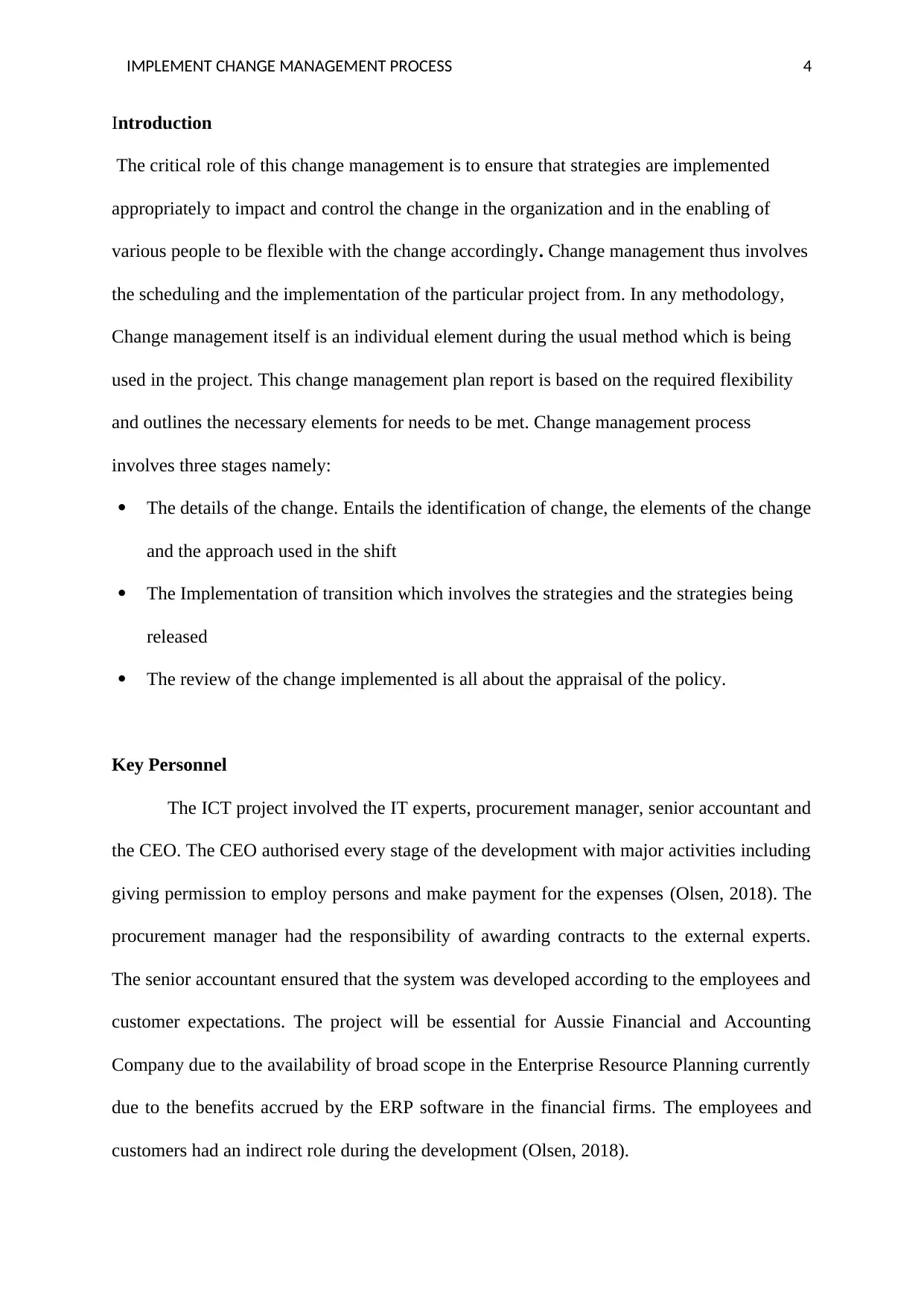
IMPLEMENT CHANGE MANAGEMENT PROCESS 4
Introduction
The critical role of this change management is to ensure that strategies are implemented
appropriately to impact and control the change in the organization and in the enabling of
various people to be flexible with the change accordingly. Change management thus involves
the scheduling and the implementation of the particular project from. In any methodology,
Change management itself is an individual element during the usual method which is being
used in the project. This change management plan report is based on the required flexibility
and outlines the necessary elements for needs to be met. Change management process
involves three stages namely:
The details of the change. Entails the identification of change, the elements of the change
and the approach used in the shift
The Implementation of transition which involves the strategies and the strategies being
released
The review of the change implemented is all about the appraisal of the policy.
Key Personnel
The ICT project involved the IT experts, procurement manager, senior accountant and
the CEO. The CEO authorised every stage of the development with major activities including
giving permission to employ persons and make payment for the expenses (Olsen, 2018). The
procurement manager had the responsibility of awarding contracts to the external experts.
The senior accountant ensured that the system was developed according to the employees and
customer expectations. The project will be essential for Aussie Financial and Accounting
Company due to the availability of broad scope in the Enterprise Resource Planning currently
due to the benefits accrued by the ERP software in the financial firms. The employees and
customers had an indirect role during the development (Olsen, 2018).
Introduction
The critical role of this change management is to ensure that strategies are implemented
appropriately to impact and control the change in the organization and in the enabling of
various people to be flexible with the change accordingly. Change management thus involves
the scheduling and the implementation of the particular project from. In any methodology,
Change management itself is an individual element during the usual method which is being
used in the project. This change management plan report is based on the required flexibility
and outlines the necessary elements for needs to be met. Change management process
involves three stages namely:
The details of the change. Entails the identification of change, the elements of the change
and the approach used in the shift
The Implementation of transition which involves the strategies and the strategies being
released
The review of the change implemented is all about the appraisal of the policy.
Key Personnel
The ICT project involved the IT experts, procurement manager, senior accountant and
the CEO. The CEO authorised every stage of the development with major activities including
giving permission to employ persons and make payment for the expenses (Olsen, 2018). The
procurement manager had the responsibility of awarding contracts to the external experts.
The senior accountant ensured that the system was developed according to the employees and
customer expectations. The project will be essential for Aussie Financial and Accounting
Company due to the availability of broad scope in the Enterprise Resource Planning currently
due to the benefits accrued by the ERP software in the financial firms. The employees and
customers had an indirect role during the development (Olsen, 2018).
Paraphrase This Document
Need a fresh take? Get an instant paraphrase of this document with our AI Paraphraser
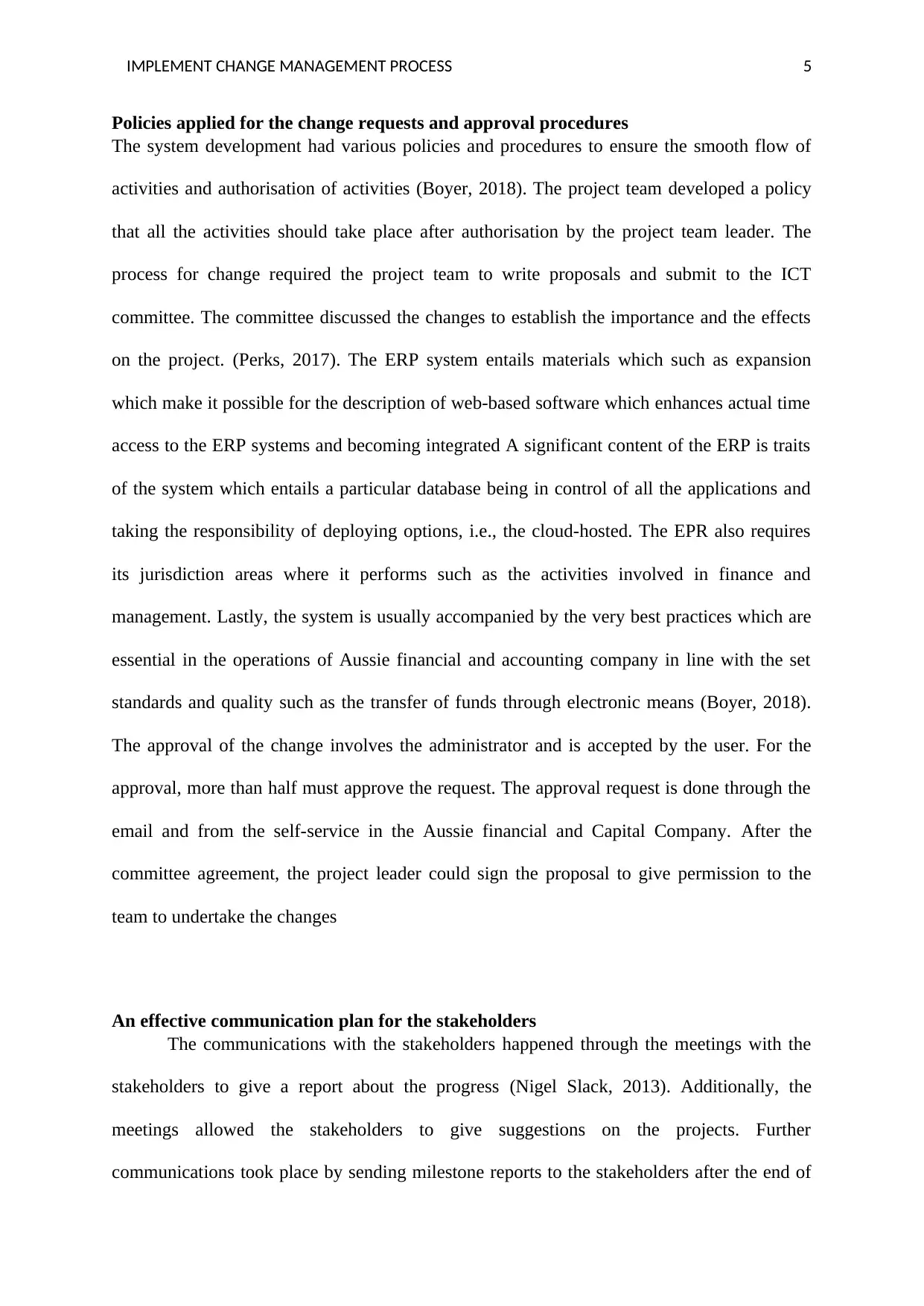
IMPLEMENT CHANGE MANAGEMENT PROCESS 5
Policies applied for the change requests and approval procedures
The system development had various policies and procedures to ensure the smooth flow of
activities and authorisation of activities (Boyer, 2018). The project team developed a policy
that all the activities should take place after authorisation by the project team leader. The
process for change required the project team to write proposals and submit to the ICT
committee. The committee discussed the changes to establish the importance and the effects
on the project. (Perks, 2017). The ERP system entails materials which such as expansion
which make it possible for the description of web-based software which enhances actual time
access to the ERP systems and becoming integrated A significant content of the ERP is traits
of the system which entails a particular database being in control of all the applications and
taking the responsibility of deploying options, i.e., the cloud-hosted. The EPR also requires
its jurisdiction areas where it performs such as the activities involved in finance and
management. Lastly, the system is usually accompanied by the very best practices which are
essential in the operations of Aussie financial and accounting company in line with the set
standards and quality such as the transfer of funds through electronic means (Boyer, 2018).
The approval of the change involves the administrator and is accepted by the user. For the
approval, more than half must approve the request. The approval request is done through the
email and from the self-service in the Aussie financial and Capital Company. After the
committee agreement, the project leader could sign the proposal to give permission to the
team to undertake the changes
An effective communication plan for the stakeholders
The communications with the stakeholders happened through the meetings with the
stakeholders to give a report about the progress (Nigel Slack, 2013). Additionally, the
meetings allowed the stakeholders to give suggestions on the projects. Further
communications took place by sending milestone reports to the stakeholders after the end of
Policies applied for the change requests and approval procedures
The system development had various policies and procedures to ensure the smooth flow of
activities and authorisation of activities (Boyer, 2018). The project team developed a policy
that all the activities should take place after authorisation by the project team leader. The
process for change required the project team to write proposals and submit to the ICT
committee. The committee discussed the changes to establish the importance and the effects
on the project. (Perks, 2017). The ERP system entails materials which such as expansion
which make it possible for the description of web-based software which enhances actual time
access to the ERP systems and becoming integrated A significant content of the ERP is traits
of the system which entails a particular database being in control of all the applications and
taking the responsibility of deploying options, i.e., the cloud-hosted. The EPR also requires
its jurisdiction areas where it performs such as the activities involved in finance and
management. Lastly, the system is usually accompanied by the very best practices which are
essential in the operations of Aussie financial and accounting company in line with the set
standards and quality such as the transfer of funds through electronic means (Boyer, 2018).
The approval of the change involves the administrator and is accepted by the user. For the
approval, more than half must approve the request. The approval request is done through the
email and from the self-service in the Aussie financial and Capital Company. After the
committee agreement, the project leader could sign the proposal to give permission to the
team to undertake the changes
An effective communication plan for the stakeholders
The communications with the stakeholders happened through the meetings with the
stakeholders to give a report about the progress (Nigel Slack, 2013). Additionally, the
meetings allowed the stakeholders to give suggestions on the projects. Further
communications took place by sending milestone reports to the stakeholders after the end of
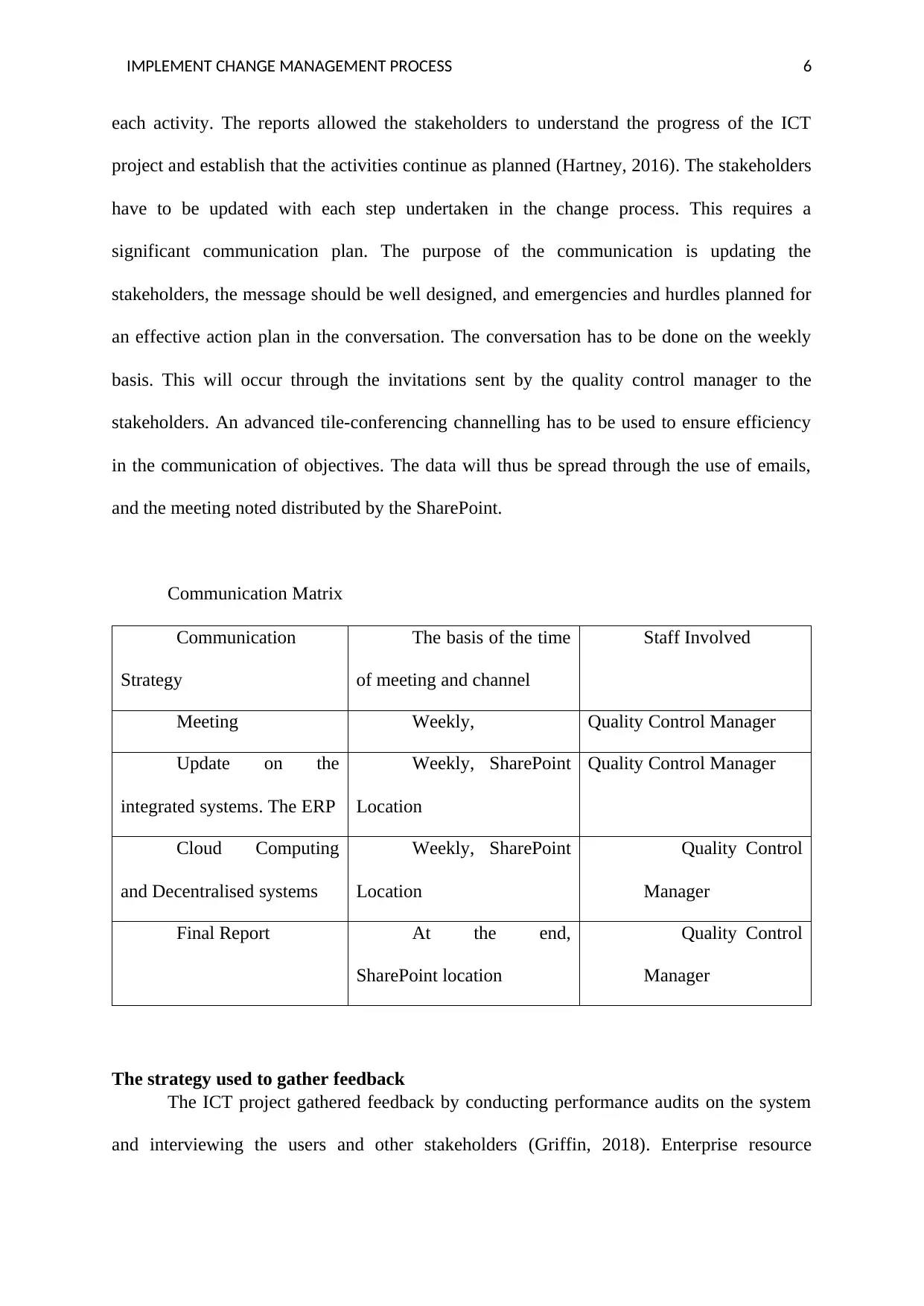
IMPLEMENT CHANGE MANAGEMENT PROCESS 6
each activity. The reports allowed the stakeholders to understand the progress of the ICT
project and establish that the activities continue as planned (Hartney, 2016). The stakeholders
have to be updated with each step undertaken in the change process. This requires a
significant communication plan. The purpose of the communication is updating the
stakeholders, the message should be well designed, and emergencies and hurdles planned for
an effective action plan in the conversation. The conversation has to be done on the weekly
basis. This will occur through the invitations sent by the quality control manager to the
stakeholders. An advanced tile-conferencing channelling has to be used to ensure efficiency
in the communication of objectives. The data will thus be spread through the use of emails,
and the meeting noted distributed by the SharePoint.
Communication Matrix
Communication
Strategy
The basis of the time
of meeting and channel
Staff Involved
Meeting Weekly, Quality Control Manager
Update on the
integrated systems. The ERP
Weekly, SharePoint
Location
Quality Control Manager
Cloud Computing
and Decentralised systems
Weekly, SharePoint
Location
Quality Control
Manager
Final Report At the end,
SharePoint location
Quality Control
Manager
The strategy used to gather feedback
The ICT project gathered feedback by conducting performance audits on the system
and interviewing the users and other stakeholders (Griffin, 2018). Enterprise resource
each activity. The reports allowed the stakeholders to understand the progress of the ICT
project and establish that the activities continue as planned (Hartney, 2016). The stakeholders
have to be updated with each step undertaken in the change process. This requires a
significant communication plan. The purpose of the communication is updating the
stakeholders, the message should be well designed, and emergencies and hurdles planned for
an effective action plan in the conversation. The conversation has to be done on the weekly
basis. This will occur through the invitations sent by the quality control manager to the
stakeholders. An advanced tile-conferencing channelling has to be used to ensure efficiency
in the communication of objectives. The data will thus be spread through the use of emails,
and the meeting noted distributed by the SharePoint.
Communication Matrix
Communication
Strategy
The basis of the time
of meeting and channel
Staff Involved
Meeting Weekly, Quality Control Manager
Update on the
integrated systems. The ERP
Weekly, SharePoint
Location
Quality Control Manager
Cloud Computing
and Decentralised systems
Weekly, SharePoint
Location
Quality Control
Manager
Final Report At the end,
SharePoint location
Quality Control
Manager
The strategy used to gather feedback
The ICT project gathered feedback by conducting performance audits on the system
and interviewing the users and other stakeholders (Griffin, 2018). Enterprise resource
⊘ This is a preview!⊘
Do you want full access?
Subscribe today to unlock all pages.

Trusted by 1+ million students worldwide
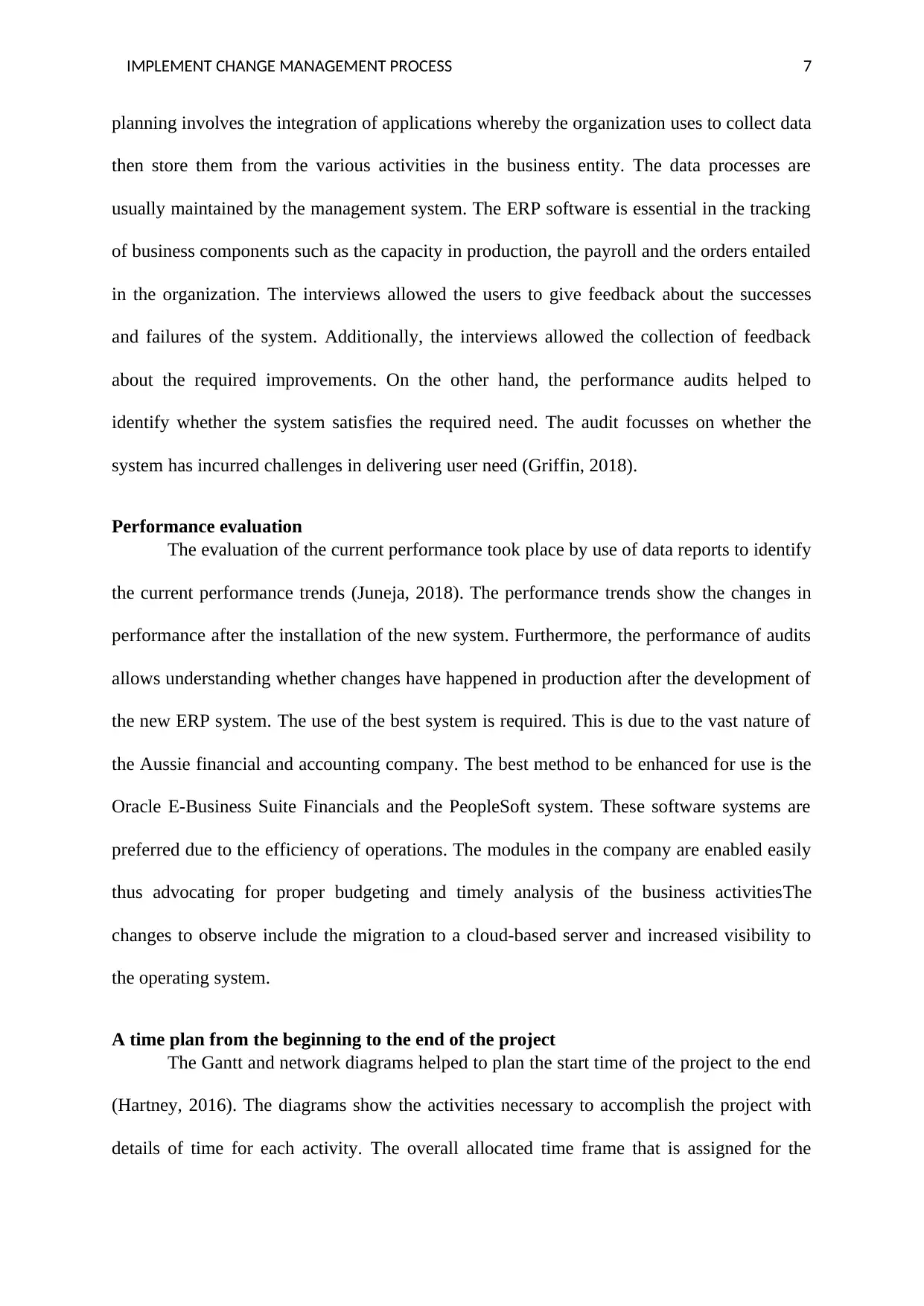
IMPLEMENT CHANGE MANAGEMENT PROCESS 7
planning involves the integration of applications whereby the organization uses to collect data
then store them from the various activities in the business entity. The data processes are
usually maintained by the management system. The ERP software is essential in the tracking
of business components such as the capacity in production, the payroll and the orders entailed
in the organization. The interviews allowed the users to give feedback about the successes
and failures of the system. Additionally, the interviews allowed the collection of feedback
about the required improvements. On the other hand, the performance audits helped to
identify whether the system satisfies the required need. The audit focusses on whether the
system has incurred challenges in delivering user need (Griffin, 2018).
Performance evaluation
The evaluation of the current performance took place by use of data reports to identify
the current performance trends (Juneja, 2018). The performance trends show the changes in
performance after the installation of the new system. Furthermore, the performance of audits
allows understanding whether changes have happened in production after the development of
the new ERP system. The use of the best system is required. This is due to the vast nature of
the Aussie financial and accounting company. The best method to be enhanced for use is the
Oracle E-Business Suite Financials and the PeopleSoft system. These software systems are
preferred due to the efficiency of operations. The modules in the company are enabled easily
thus advocating for proper budgeting and timely analysis of the business activitiesThe
changes to observe include the migration to a cloud-based server and increased visibility to
the operating system.
A time plan from the beginning to the end of the project
The Gantt and network diagrams helped to plan the start time of the project to the end
(Hartney, 2016). The diagrams show the activities necessary to accomplish the project with
details of time for each activity. The overall allocated time frame that is assigned for the
planning involves the integration of applications whereby the organization uses to collect data
then store them from the various activities in the business entity. The data processes are
usually maintained by the management system. The ERP software is essential in the tracking
of business components such as the capacity in production, the payroll and the orders entailed
in the organization. The interviews allowed the users to give feedback about the successes
and failures of the system. Additionally, the interviews allowed the collection of feedback
about the required improvements. On the other hand, the performance audits helped to
identify whether the system satisfies the required need. The audit focusses on whether the
system has incurred challenges in delivering user need (Griffin, 2018).
Performance evaluation
The evaluation of the current performance took place by use of data reports to identify
the current performance trends (Juneja, 2018). The performance trends show the changes in
performance after the installation of the new system. Furthermore, the performance of audits
allows understanding whether changes have happened in production after the development of
the new ERP system. The use of the best system is required. This is due to the vast nature of
the Aussie financial and accounting company. The best method to be enhanced for use is the
Oracle E-Business Suite Financials and the PeopleSoft system. These software systems are
preferred due to the efficiency of operations. The modules in the company are enabled easily
thus advocating for proper budgeting and timely analysis of the business activitiesThe
changes to observe include the migration to a cloud-based server and increased visibility to
the operating system.
A time plan from the beginning to the end of the project
The Gantt and network diagrams helped to plan the start time of the project to the end
(Hartney, 2016). The diagrams show the activities necessary to accomplish the project with
details of time for each activity. The overall allocated time frame that is assigned for the
Paraphrase This Document
Need a fresh take? Get an instant paraphrase of this document with our AI Paraphraser
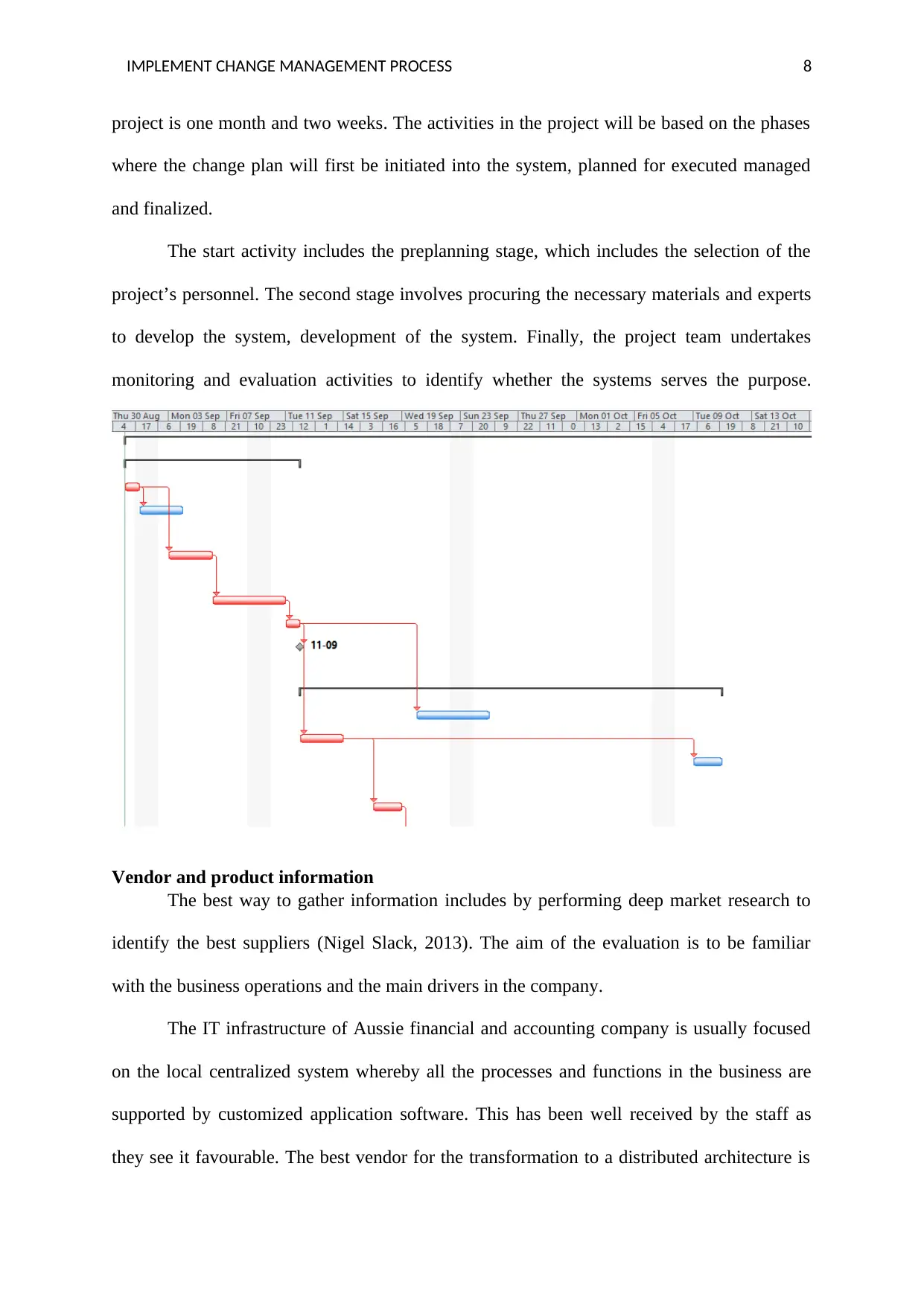
IMPLEMENT CHANGE MANAGEMENT PROCESS 8
project is one month and two weeks. The activities in the project will be based on the phases
where the change plan will first be initiated into the system, planned for executed managed
and finalized.
The start activity includes the preplanning stage, which includes the selection of the
project’s personnel. The second stage involves procuring the necessary materials and experts
to develop the system, development of the system. Finally, the project team undertakes
monitoring and evaluation activities to identify whether the systems serves the purpose.
Vendor and product information
The best way to gather information includes by performing deep market research to
identify the best suppliers (Nigel Slack, 2013). The aim of the evaluation is to be familiar
with the business operations and the main drivers in the company.
The IT infrastructure of Aussie financial and accounting company is usually focused
on the local centralized system whereby all the processes and functions in the business are
supported by customized application software. This has been well received by the staff as
they see it favourable. The best vendor for the transformation to a distributed architecture is
project is one month and two weeks. The activities in the project will be based on the phases
where the change plan will first be initiated into the system, planned for executed managed
and finalized.
The start activity includes the preplanning stage, which includes the selection of the
project’s personnel. The second stage involves procuring the necessary materials and experts
to develop the system, development of the system. Finally, the project team undertakes
monitoring and evaluation activities to identify whether the systems serves the purpose.
Vendor and product information
The best way to gather information includes by performing deep market research to
identify the best suppliers (Nigel Slack, 2013). The aim of the evaluation is to be familiar
with the business operations and the main drivers in the company.
The IT infrastructure of Aussie financial and accounting company is usually focused
on the local centralized system whereby all the processes and functions in the business are
supported by customized application software. This has been well received by the staff as
they see it favourable. The best vendor for the transformation to a distributed architecture is

IMPLEMENT CHANGE MANAGEMENT PROCESS 9
the met information system to break away from the old ways. The best suppliers for the
system includes the expandable software suppliers who offer high-quality systems that meet
international standards. The expendables supply the expandable software that performs
enterprise resource planning activities. The software suppliers have the best experts to
decentralise the system used by the company and serve the customers better than when using
the current system.
Impact analysis
The, impact analysis would be carried out using performance audits to identify
improvements in operations (Olsen, 2018). The key factors to observe includes checking
whether the new system gives complete visibility to the system, reduces costs of operations,
decentralises operations to all branches within the country, reduces manual work and replaces
the local servers with cloud-based servers. Additionally, the impact analysis happens by
collecting data from the customers to identify levels of satisfaction and efficiency resulting
from the new system.
Impact Analysis Report
Change
requirement
Functionality
Score
Impact
Score
Ranking in
the company
EPR 6 6 18
Decentralised
system
5 4 20
Cloud
Computing
3 5 25
the met information system to break away from the old ways. The best suppliers for the
system includes the expandable software suppliers who offer high-quality systems that meet
international standards. The expendables supply the expandable software that performs
enterprise resource planning activities. The software suppliers have the best experts to
decentralise the system used by the company and serve the customers better than when using
the current system.
Impact analysis
The, impact analysis would be carried out using performance audits to identify
improvements in operations (Olsen, 2018). The key factors to observe includes checking
whether the new system gives complete visibility to the system, reduces costs of operations,
decentralises operations to all branches within the country, reduces manual work and replaces
the local servers with cloud-based servers. Additionally, the impact analysis happens by
collecting data from the customers to identify levels of satisfaction and efficiency resulting
from the new system.
Impact Analysis Report
Change
requirement
Functionality
Score
Impact
Score
Ranking in
the company
EPR 6 6 18
Decentralised
system
5 4 20
Cloud
Computing
3 5 25
⊘ This is a preview!⊘
Do you want full access?
Subscribe today to unlock all pages.

Trusted by 1+ million students worldwide
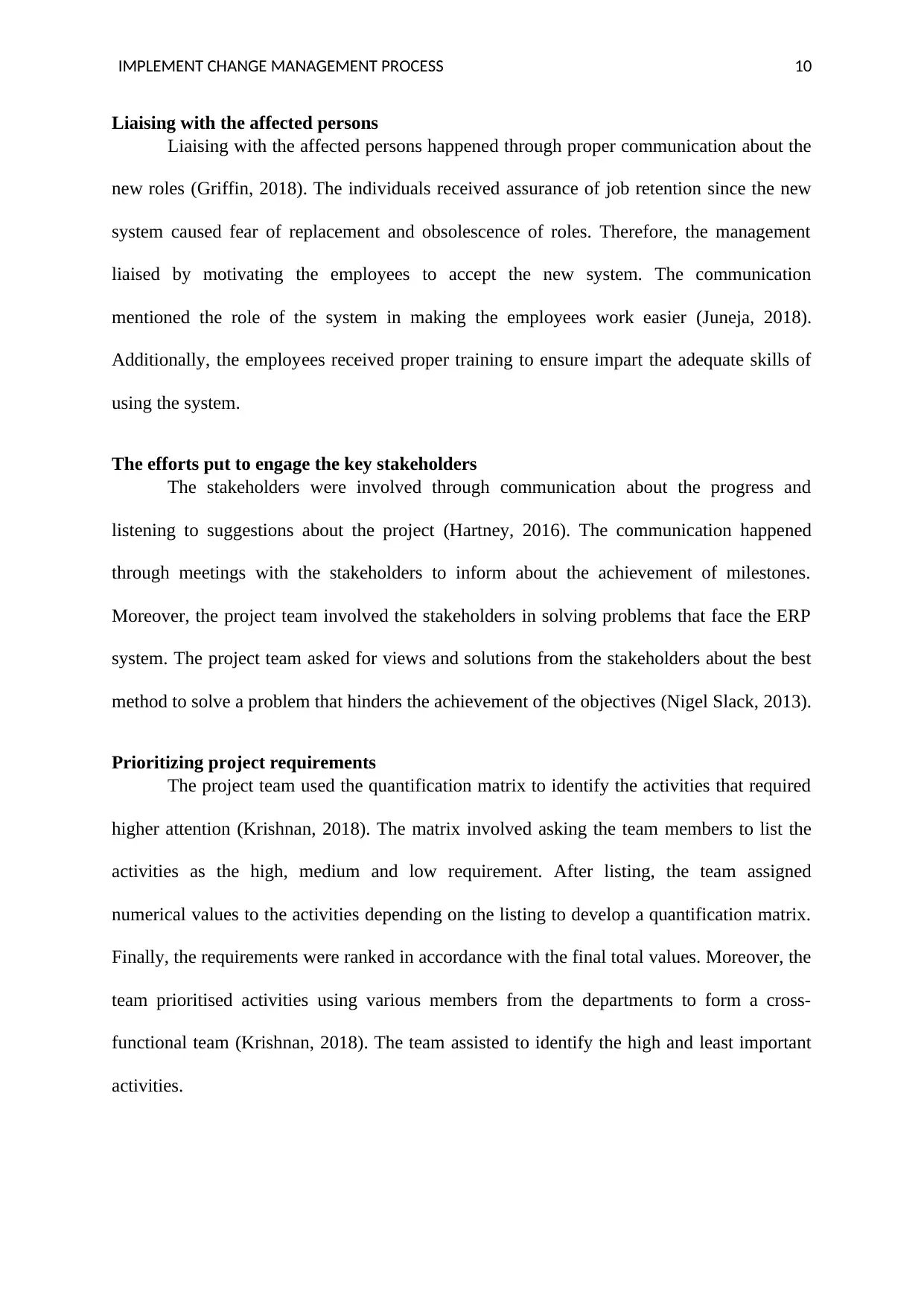
IMPLEMENT CHANGE MANAGEMENT PROCESS 10
Liaising with the affected persons
Liaising with the affected persons happened through proper communication about the
new roles (Griffin, 2018). The individuals received assurance of job retention since the new
system caused fear of replacement and obsolescence of roles. Therefore, the management
liaised by motivating the employees to accept the new system. The communication
mentioned the role of the system in making the employees work easier (Juneja, 2018).
Additionally, the employees received proper training to ensure impart the adequate skills of
using the system.
The efforts put to engage the key stakeholders
The stakeholders were involved through communication about the progress and
listening to suggestions about the project (Hartney, 2016). The communication happened
through meetings with the stakeholders to inform about the achievement of milestones.
Moreover, the project team involved the stakeholders in solving problems that face the ERP
system. The project team asked for views and solutions from the stakeholders about the best
method to solve a problem that hinders the achievement of the objectives (Nigel Slack, 2013).
Prioritizing project requirements
The project team used the quantification matrix to identify the activities that required
higher attention (Krishnan, 2018). The matrix involved asking the team members to list the
activities as the high, medium and low requirement. After listing, the team assigned
numerical values to the activities depending on the listing to develop a quantification matrix.
Finally, the requirements were ranked in accordance with the final total values. Moreover, the
team prioritised activities using various members from the departments to form a cross-
functional team (Krishnan, 2018). The team assisted to identify the high and least important
activities.
Liaising with the affected persons
Liaising with the affected persons happened through proper communication about the
new roles (Griffin, 2018). The individuals received assurance of job retention since the new
system caused fear of replacement and obsolescence of roles. Therefore, the management
liaised by motivating the employees to accept the new system. The communication
mentioned the role of the system in making the employees work easier (Juneja, 2018).
Additionally, the employees received proper training to ensure impart the adequate skills of
using the system.
The efforts put to engage the key stakeholders
The stakeholders were involved through communication about the progress and
listening to suggestions about the project (Hartney, 2016). The communication happened
through meetings with the stakeholders to inform about the achievement of milestones.
Moreover, the project team involved the stakeholders in solving problems that face the ERP
system. The project team asked for views and solutions from the stakeholders about the best
method to solve a problem that hinders the achievement of the objectives (Nigel Slack, 2013).
Prioritizing project requirements
The project team used the quantification matrix to identify the activities that required
higher attention (Krishnan, 2018). The matrix involved asking the team members to list the
activities as the high, medium and low requirement. After listing, the team assigned
numerical values to the activities depending on the listing to develop a quantification matrix.
Finally, the requirements were ranked in accordance with the final total values. Moreover, the
team prioritised activities using various members from the departments to form a cross-
functional team (Krishnan, 2018). The team assisted to identify the high and least important
activities.
Paraphrase This Document
Need a fresh take? Get an instant paraphrase of this document with our AI Paraphraser
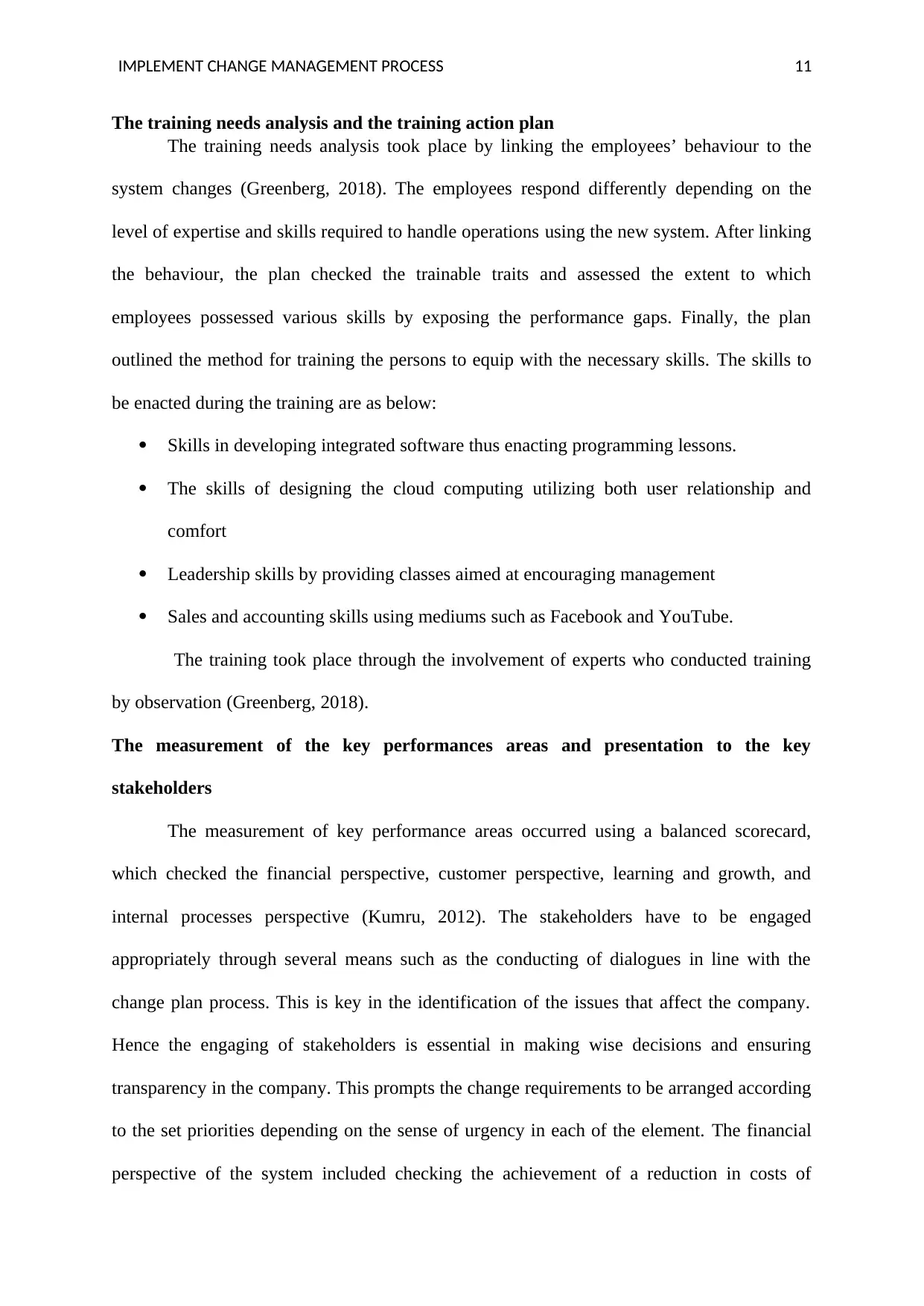
IMPLEMENT CHANGE MANAGEMENT PROCESS 11
The training needs analysis and the training action plan
The training needs analysis took place by linking the employees’ behaviour to the
system changes (Greenberg, 2018). The employees respond differently depending on the
level of expertise and skills required to handle operations using the new system. After linking
the behaviour, the plan checked the trainable traits and assessed the extent to which
employees possessed various skills by exposing the performance gaps. Finally, the plan
outlined the method for training the persons to equip with the necessary skills. The skills to
be enacted during the training are as below:
Skills in developing integrated software thus enacting programming lessons.
The skills of designing the cloud computing utilizing both user relationship and
comfort
Leadership skills by providing classes aimed at encouraging management
Sales and accounting skills using mediums such as Facebook and YouTube.
The training took place through the involvement of experts who conducted training
by observation (Greenberg, 2018).
The measurement of the key performances areas and presentation to the key
stakeholders
The measurement of key performance areas occurred using a balanced scorecard,
which checked the financial perspective, customer perspective, learning and growth, and
internal processes perspective (Kumru, 2012). The stakeholders have to be engaged
appropriately through several means such as the conducting of dialogues in line with the
change plan process. This is key in the identification of the issues that affect the company.
Hence the engaging of stakeholders is essential in making wise decisions and ensuring
transparency in the company. This prompts the change requirements to be arranged according
to the set priorities depending on the sense of urgency in each of the element. The financial
perspective of the system included checking the achievement of a reduction in costs of
The training needs analysis and the training action plan
The training needs analysis took place by linking the employees’ behaviour to the
system changes (Greenberg, 2018). The employees respond differently depending on the
level of expertise and skills required to handle operations using the new system. After linking
the behaviour, the plan checked the trainable traits and assessed the extent to which
employees possessed various skills by exposing the performance gaps. Finally, the plan
outlined the method for training the persons to equip with the necessary skills. The skills to
be enacted during the training are as below:
Skills in developing integrated software thus enacting programming lessons.
The skills of designing the cloud computing utilizing both user relationship and
comfort
Leadership skills by providing classes aimed at encouraging management
Sales and accounting skills using mediums such as Facebook and YouTube.
The training took place through the involvement of experts who conducted training
by observation (Greenberg, 2018).
The measurement of the key performances areas and presentation to the key
stakeholders
The measurement of key performance areas occurred using a balanced scorecard,
which checked the financial perspective, customer perspective, learning and growth, and
internal processes perspective (Kumru, 2012). The stakeholders have to be engaged
appropriately through several means such as the conducting of dialogues in line with the
change plan process. This is key in the identification of the issues that affect the company.
Hence the engaging of stakeholders is essential in making wise decisions and ensuring
transparency in the company. This prompts the change requirements to be arranged according
to the set priorities depending on the sense of urgency in each of the element. The financial
perspective of the system included checking the achievement of a reduction in costs of
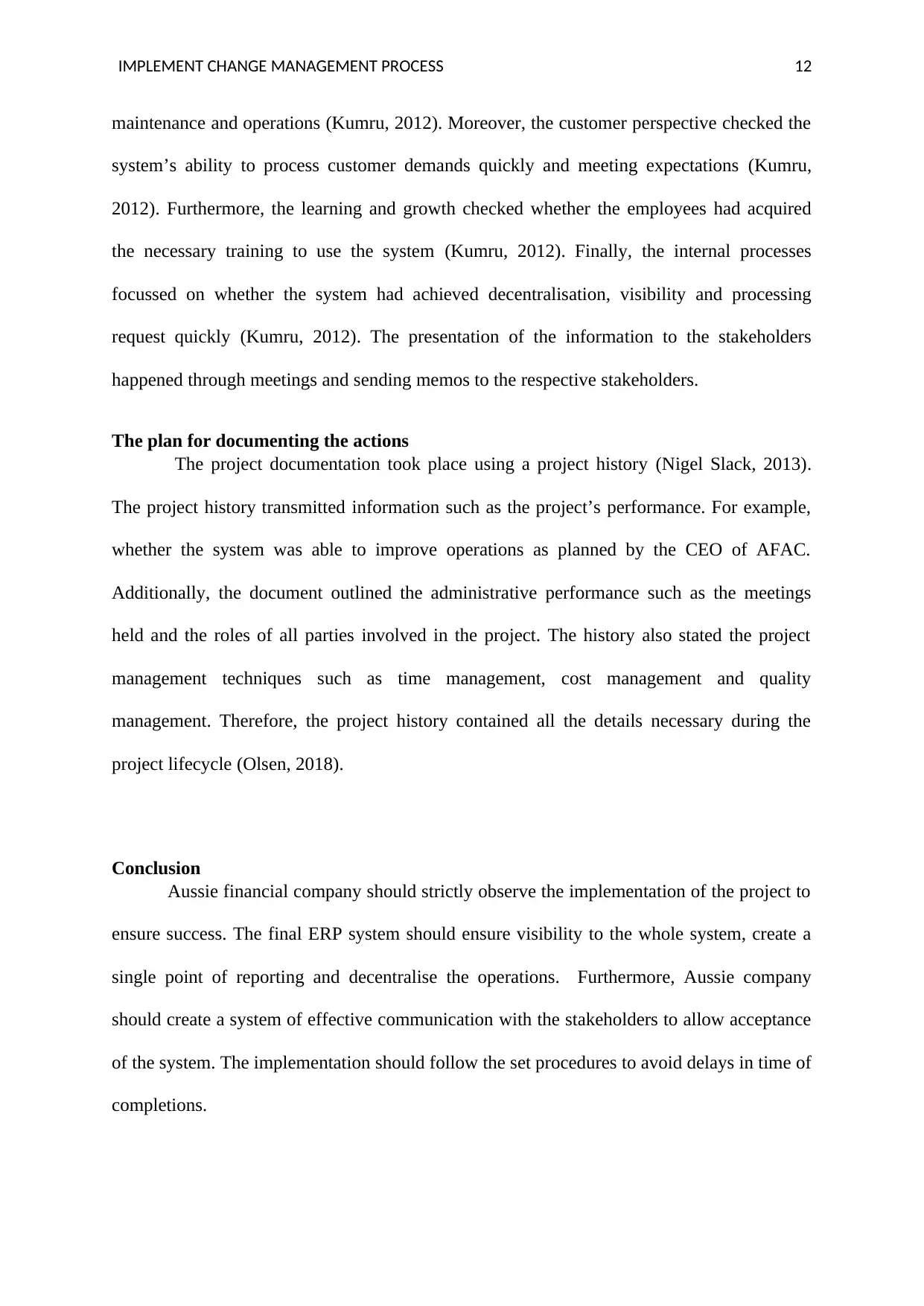
IMPLEMENT CHANGE MANAGEMENT PROCESS 12
maintenance and operations (Kumru, 2012). Moreover, the customer perspective checked the
system’s ability to process customer demands quickly and meeting expectations (Kumru,
2012). Furthermore, the learning and growth checked whether the employees had acquired
the necessary training to use the system (Kumru, 2012). Finally, the internal processes
focussed on whether the system had achieved decentralisation, visibility and processing
request quickly (Kumru, 2012). The presentation of the information to the stakeholders
happened through meetings and sending memos to the respective stakeholders.
The plan for documenting the actions
The project documentation took place using a project history (Nigel Slack, 2013).
The project history transmitted information such as the project’s performance. For example,
whether the system was able to improve operations as planned by the CEO of AFAC.
Additionally, the document outlined the administrative performance such as the meetings
held and the roles of all parties involved in the project. The history also stated the project
management techniques such as time management, cost management and quality
management. Therefore, the project history contained all the details necessary during the
project lifecycle (Olsen, 2018).
Conclusion
Aussie financial company should strictly observe the implementation of the project to
ensure success. The final ERP system should ensure visibility to the whole system, create a
single point of reporting and decentralise the operations. Furthermore, Aussie company
should create a system of effective communication with the stakeholders to allow acceptance
of the system. The implementation should follow the set procedures to avoid delays in time of
completions.
maintenance and operations (Kumru, 2012). Moreover, the customer perspective checked the
system’s ability to process customer demands quickly and meeting expectations (Kumru,
2012). Furthermore, the learning and growth checked whether the employees had acquired
the necessary training to use the system (Kumru, 2012). Finally, the internal processes
focussed on whether the system had achieved decentralisation, visibility and processing
request quickly (Kumru, 2012). The presentation of the information to the stakeholders
happened through meetings and sending memos to the respective stakeholders.
The plan for documenting the actions
The project documentation took place using a project history (Nigel Slack, 2013).
The project history transmitted information such as the project’s performance. For example,
whether the system was able to improve operations as planned by the CEO of AFAC.
Additionally, the document outlined the administrative performance such as the meetings
held and the roles of all parties involved in the project. The history also stated the project
management techniques such as time management, cost management and quality
management. Therefore, the project history contained all the details necessary during the
project lifecycle (Olsen, 2018).
Conclusion
Aussie financial company should strictly observe the implementation of the project to
ensure success. The final ERP system should ensure visibility to the whole system, create a
single point of reporting and decentralise the operations. Furthermore, Aussie company
should create a system of effective communication with the stakeholders to allow acceptance
of the system. The implementation should follow the set procedures to avoid delays in time of
completions.
⊘ This is a preview!⊘
Do you want full access?
Subscribe today to unlock all pages.

Trusted by 1+ million students worldwide
1 out of 14
Related Documents
Your All-in-One AI-Powered Toolkit for Academic Success.
+13062052269
info@desklib.com
Available 24*7 on WhatsApp / Email
![[object Object]](/_next/static/media/star-bottom.7253800d.svg)
Unlock your academic potential
Copyright © 2020–2025 A2Z Services. All Rights Reserved. Developed and managed by ZUCOL.





